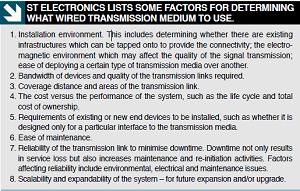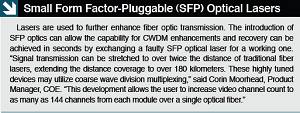With convergence heating up, transmission plays a crucial role in an integrated security solution. There are many options to choose from, depending on the devices used and the environment they operate in.
With convergence heating up, transmission plays a crucial role in an integrated security solution. There are many options to choose from, depending on the devices used and the environment they operate in.
Wireless maybe an industry buzzword, but wired transmission technology still dominates today. Its reliability and ability to transmit data efficiently continues to be relevant. To determine the type of transmission medium most suitable for a project, one must perform clear calculations, understand the environment of the project, and fully understand the user's requirements.
There is no one-size-fits-all solution. "The info-communication requirements for various integrated systems can be vastly different between a campus-wide complex, an integrated resort or a mass rapid transit infrastructure," said Thong Hsi, Division Manager, Integrated Communications Division, ST Electronics. “The choice of medium gets more complex, especially for large scale projects that involve thousands of access control/points and subsystems. A project's requirements, limitations and cost constraints need to be evaluated to figure out advantages and disadvantages of various wired transmission media.”
It is crucial to find the right transmission medium based on the environment of the system. A home installation can be simple, while transmission for a transit system will include many different mediums.
 Power Line Cables
Power Line Cables
For many home installations, power cables are sufficient to transmit data from one device to another. “Power line transmission cannot extend past 600 to 800 meters with power, rendering them only suitable for small offices or homes,” said Ben Chiang, Product Manager at EtherWAN Systems. Data is passed through the power cables in the form of electricity
Power cables require minimum costs, since they are already present. “Power line is a good and low-priced solution for installations where no network cables are installed,” said Michael Blottnicki, Business Development Manager, IP Video Systems, Europe, Plustek. Integration can be achieved by the user, thus saving on installation costs.
The power cable's advantage of using available infrastructure may also be its greatest disadvantage. “Since everything is connected, it leads to more disturbances,” said Peter De Konink, Product Manager of Codecs and Analytics, Optelecom-NKF.
Copper Wire CAB LES
There are two types of copper wire cables — phone wires and twisted pair cables. Much like power line cables, network cables are easily available. They have RJ-45 connectors and are widely used for computer networking, such as connecting computers to a broadband network. But if there is no existing infrastructure to work with, network cables have higher costs. “Network cables are much more expensive to install compared to utilizing power cables,” Blottnicki said.
 Unshielded twisted pair (UTP) and shielded twisted pair (STP) cables are pairs of wires that form a circuit to transmit binary data, said Mark Wilson, VP of Marketing, Infinova. “UTP cable is easy to install and is less expensive than any other type of transmission wire. Depending on the category, they can transmit data from 10 megabits per second (Mbps) to one gigabit per second (Gbps). It can also be used in most major architectures of network systems,” he said.
Unshielded twisted pair (UTP) and shielded twisted pair (STP) cables are pairs of wires that form a circuit to transmit binary data, said Mark Wilson, VP of Marketing, Infinova. “UTP cable is easy to install and is less expensive than any other type of transmission wire. Depending on the category, they can transmit data from 10 megabits per second (Mbps) to one gigabit per second (Gbps). It can also be used in most major architectures of network systems,” he said.
UTP cabling can produce fiber-like video quality at a fraction of the cost and is a tenth the size of coaxial cables, while carrying more data. "UTP cables are easy to install, test and troubleshoot due to their color coding," said Guy Apple, VP of Marketing and Sales, Network Video Technologies. They are fully compatible with all structured datacom networks and can be used for both analog and IP devices.
They are suitable for both video only and for integrated solutions, said Sara Bullock, International Sales Director, AMG Systems.
However, they carry disadvantages.“Electrical noise and other interferences can easily affect the quality of the data,” Wilson said. “Even though IP-based video is gaining users, there remains a serious distance limitation with UTP cabling infrastructure, which hinders the placement of cameras. For example, if a camera is located 1,000 feet from the head-end without any active signal conditioning, about 37 percent of the information will be lost in transmission. This is not counting the need and cost for signal amplification, ground fault correction and surge protection.”
 Transmission distances need be considered, especially above 250 to 300 meters. They operate on point-topoint (PtP) only and the maximum length for IP data is 100 meters using Cat-5 or Cat-6 cables, Bullock said.
Transmission distances need be considered, especially above 250 to 300 meters. They operate on point-topoint (PtP) only and the maximum length for IP data is 100 meters using Cat-5 or Cat-6 cables, Bullock said.
CoaxiaL CABLES
Coaxial cables cost more than twisted-pair cables, but are still considered cost-effective and outperform twisted pair. “Coaxial cable is widely used because it supports 10 to 100 Mbps, whether it is a thin or thick coaxial cable. It can transfer data approximately 1,600 feet, which is around five times greater than twisted pair cables. It also has lower error rates,” Wilson said. “They work by transmitting electromagnetic waves through the dielectric inside the cable between the conductors.”
The picture quality for phase alternate line (PAL) and national system television commitee (NTSC) cameras is perfectly adequate using coaxial cables, and no significant degradation can be found when transmitting up to 300 meters. Another issue is that multiple camera signals cannot be run on a single coaxial cable because of the limited bandwidth. Therefore, each camera needs its own dedicated cable, Bullock said. “They are simple and easy to install and maintain — no specialist connection techniques are required and no active transmission equipment is needed.”
The downside of coaxial cabling lies in how certain systems may require dedicated wiring, meaning it can be system-specific. This makes upgrades difficult. Coaxial cables are bulky and can only perform with PtP typology, Bullock  said.
said.
The difficulty in using coaxial cables comes from a lack of cabling or network standards. “Coaxial cables are also more difficult to terminate and have a rather limited future,”Apple said.
Coaxial cables are only suitable for small area networks less than 600 meters in distance, but are a good fit due to their low costs, Bullock said.
Fiber OPTIC CABLES
Fiber optic cables are strands of optically pure glass — as thin as a human hair — that carry digital information over long distances. “These strands are regularly bundled and insulated in cable,” said Corin Moorhead, Product Manager, COE. “Digital video transmission across optical cable occurs at the speed of light, and the only limit to the level of video data that can be transmitted simultaneously across optical fiber is the ability of the devices at each end of the cable to interpret and distribute this data.”
The global market for fiber optics in security applications is around US$120 million to $150 million, said Joseph Frank, Sales Director, Americas, OT Systems. Fiber cable is considered the best option for long distances and has the best transmission quality.

Compared to other transmission media, fiber optics can go great distances with little or no amplifier. “They can transmit distances up to 120 kilometers,” said Jack Xu, Marketing and Sales Director, Overseas Business Department, OB Telecom lectronics.
There is less signal degradation with fiber optics. “They are immune to external electromagnetic disturbances,” De Konink said.
Fiber has a low rate of error and resists electrical and magnetic interferences, ilson said. “It also provides extremely high bandwidth — the bandwidth capacity of a single strand of standard multimode fiber is more than 45 times that of a Cat-5 cable, while the maximum bandwidth capacity of single-mode fiber has yet to be reached, according to fiber optics experts,” he said. It is small, providing better tensile strength than other wired cables.
Transmitters interpret electronic data into light, and fiber optic cables transmit the light to the other end. The receiving end then interpretsit back into electronic data. “Fiber optic cables can transmit data in this fashion at one Gbps,” Wilson said.
 Fiber cables are considered more stable. “Fiber optic transmission is well-suited for industries such as petrochemical, eliminating the risk of sparking,” Moorhead said. “The ability of fiber optics to instantly transmit high channel counts of uncompressed video over many miles is also valuable.” Transmission capacity goes up to 1.25 Gb, compared to an Ethernet transmission that is limited to 100 Mbps.
Fiber cables are considered more stable. “Fiber optic transmission is well-suited for industries such as petrochemical, eliminating the risk of sparking,” Moorhead said. “The ability of fiber optics to instantly transmit high channel counts of uncompressed video over many miles is also valuable.” Transmission capacity goes up to 1.25 Gb, compared to an Ethernet transmission that is limited to 100 Mbps.
The advantages of fiber make it the most widely selected transmission medium for security applications such as airports, city surveillance, campus environments, factories, shopping malls, transportation and all other applications where long distances and/or high loads of signal transmission are required.
There are two types of fiber optic cables: multimode and single-mode. Multimode fiber cables were once less costly, but had a lower bandwidth and transmission distance. Single-mode fiber cables have a much higher bandwidth and transmission distance, and their price has been lowered to cost less than that of multimode fiber cables. “By upgrading older systems, which relied on multimode fiber to a single-mode fiber network, and also using the correct transmission devices for single-mode fiber; a system communication bandwidth and distance capabilities can be largely increased while saving time, money and other resources by minimizing the number of fibers used.”
Mixed Transmission
As more installations combine IP and existing analog devices, transmission technologies can be mixed to create a single hybrid ntegrated solution. “A system which incorporates both network and analog cameras transmits both types of signals back on the same transmission system,” Bullock said. “Likewise, coaxial or twisted-pair cables can bring back signals from short-distance cameras to a cluster point and then transmit them onwards onto fiber-optic cables.”
By mixing ansmission technologies, cost issues are addressed. For example, it may be too costly to wire a whole system using fiber, so it is only applied to critical areas while the rest of the system uses more affordable cabling. As systems are built on top of existing infrastructures, it can be costly and labor-intensive to remove existing wiring. This is why new wiring is added to the existing infrastructure. “When planning for the future, it can be time-consuming and often difficult to determine link type and availability after cables have been installed, which is why mixing transmissions is often a good idea,” Wilson said.
 Integrating different transmission technologies for a single installation is achieved by applying different switches to integrate different transmission technologies, Xu said.
Integrating different transmission technologies for a single installation is achieved by applying different switches to integrate different transmission technologies, Xu said.
Combining transmission technologies was not the case until recently. “For older types of installations, integration of different signals were rarely used: there were coaxial cables used for video transmission, twisted pair for control signals (RS-485/422) and power cables for powering the equipment. Integration started when control signals were inserted and transmitted together with video signals over coaxial cable, so twisted pair cable were not needed anymore in these types of installations,” Frank said.
Another type of integration started with coaxial to UTP converters, which enabled video transmission over UTP cables, Frank said. One four-pair UTP cable was able to transmit one or two video signals, one control signal and even low-level power signals. Due to instability and poor immunity to RFI/EMI, this type of transmission is rarely used for demanding installations.
Higher levels of integration are achieved using IP protocols in electronic security applications.Multiple channels of video, control, audio and other signals can be
transmitted over one UTP cable, Frank said.
However, there are many problems to tackle. The integration, along with the number of signal transmission possibilities, limits the bandwidth. In security applications, the maximum distance that can be covered with UTP cables is insufficient. “Switches, repeaters and boosters must be used, and they take away from the reliability of the entire system,” Frank said.
Fiber optics became the answer to these problems. “The superiority over other transmission media in terms of distance and bandwidth allowed for many channels of video, control, audio, contact closures, IP and other signals to be transmitted over a single fiber core,” Frank said.